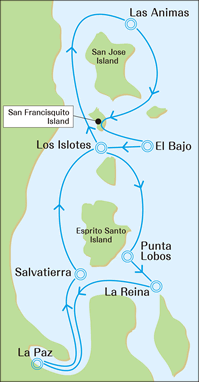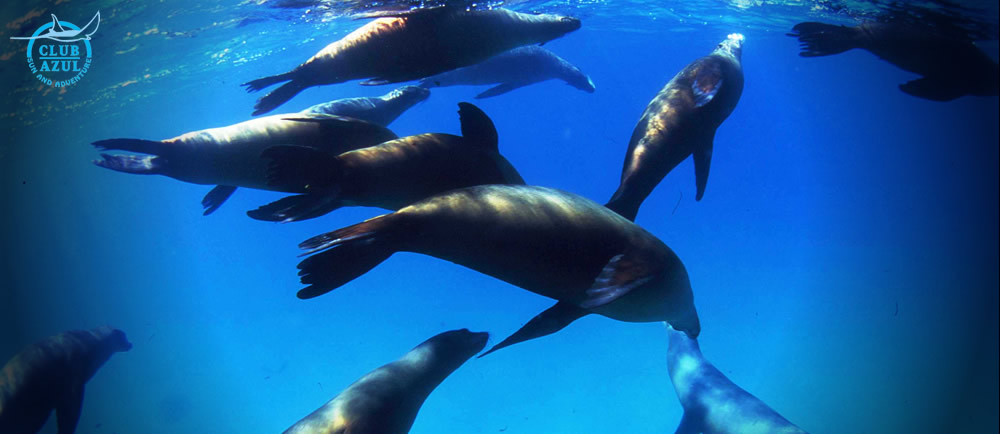| Diving points |
| * |
Los Islotes |
| * |
El Bajo |
| * |
La Reina |
| * |
La Reinita |
| * |
Punta Lobos |
| * |
Whale Island |
| * |
La Paz Bay |
| * |
Swanne Reef |
| * |
Salvatierra Wreck |
| * |
El Coralito |
|
 |
|
|
| Los Islotes |
This is the diving point, where you can 100 percent encounter sea lions. The big rock that sticks out from the ocean is where the colony of over 400 sea lions live.
In addition to sea lions there are also unique fish you can expect to see.
At the south side of the rock, on the sand with a water depth about 46 to 60 ft, you can find giant Bluespotted Jawfish showing their faces from the sand. They have a fist-sized head. Also Mobula rays are sometimes passing by.
And you can expect other encounters of schools of migratory fish such as the Mexican Barracuda, when you come through the arch from south side to northeast side. Even whale sharks have been seen at this point!
During June and July, you can see the newborn sea lion babies on the rock.
It is very fun that young growing sea lions, which were born last year, go zipping around underwater surprising scuba divers. For your information, the newborn babies start playing with scuba divers underwater in the middle of September.
Their playroom is in the cave of the south side. They are so playful that they nibble divers’ fins and snorkels softly. Their big round eyes are very impressive. The babies are the most active during November to May.
|
|
Fins and snorkels are a toy for the baby sea lions. For divers, the feeling of being bitten by the babies is a good feeling!? |
|
Beside sea lions, this point is full of macro, such as Gobies and sea slugs. SARDINA (the school of sardines) is also one of the specialties here in Los Islotes. |
 |
| El Bajo |
El Bajo is well known to have hammerhead sharks, whale sharks and marlin. There are three seamounts and even the pinnacles of the reefs are still 59 to 72 ft of deep. Mostly we do drift dives here from one of the pinnacle to 98 ft aiming to see hammerhead sharks.
During diving here, you can be surrounded by hundreds of bonitos or skip jacks. Then a hundred of parent-child hammerhead sharks pass by you snaking their head and body! It is a thrilling experience!
Besides that, you can see marlin passing in front of you and whale sharks swimming passing you on the way to descent or ascent. “El Bajo” is captivating with so many gorgeous big-fish, it is so hard to take a break until you get back on board.
|
|
|
| La Reina |
Recently this point has become common place to find enormous schools of skip jacks. Their diameter can be up to 65 ft. The schools are so big that you can feel that you are facing a big wall that almost beat you down. There is a lighthouse on the center of the enormous rock, and some sea lions make it their habitat. It is a great scene to see the sea lions burst into the wall of jacks. “La Reina” has a variety of point that you can see a ship wreck and migratory fish.
“La Reina” used to be a famous point to see Manta rays about a few years ago. Currently some big, 16-ft-class, Manta rays come here to be cleaned on an irregular basis. Only La Paz can offer the beautiful view where Manta rays and sea lions swim together!!
|
|
|
| La Reinita |
“La Reina” means “the queen,” and “La Reinita” means “the princess.” There is a small seamount next to Cerralvo island and we scuba dive around this seamount. You can see very fat Cortez garden eels have their half body stick out all over the sand area. And we can also see barracudas, snappers and many various colors of fish.
Around this point, you can see a high ratio of dolphins and whales from the boat.
|
|
| Punta Lobos |
This is a famous point with Mobula rays. Groups of 20 are common and visible in many areas. The Mobula season starts from July.
During September and October, all these groups get together. The number can be thousands! In this season, when you go off shore from the entry point, you can see them packed from the surface to the bottom with very little space between.
And although you try hard very enough to proceed you never get out from the big school of Mobula rays. On the surface of the water, you can see the Mobula rays jumping around and rolling upside down. |
|
|
| Whale Island |
This precipitous island looks like a whale. That’s the reason why it has the name. On the southwest side of the island there is a ship wreck and some caves lead to the north side. You can see many of seafans inside of the caves.
After you enjoy the feeling of exploration using your underwater light up in the cave, you are welcomed by Cortez angel fish around the exit area. Please watch your fins and guages when you pass through the caves not to bang and break these seafans. |
|
|
| La Paz Bay |
Recently this point has become common place to find whale shark. We are offering "Whale shark serch program" on last day. NO diving. you can enjoy to swim with Whale shark.
|
|
|
| Swanne Reef |
There is an isolated reef in the white sand area. This is a fish paradise with many fish. You cannot see anything but a multitude of Mexican goatfish and Spottail grunt fish. Please do not get lost with your buddy because of these fish. On the other hand, you can see Signal blennies as famous macro photography site, you never get tired of watching them emit their back fin three times and go back into the hole. Don’t miss this photo opportunity!
You can also see schools of Skip jacks and Barracudas. Sea lions sometimes burst into the cluster. We recommend this area if you wish to scuba dive with ease.
|
|
|
| Salvatierra Wreck |
Water depth is about 65 ft. and there is a 262-ft-length ferry in almost complete condition. It has become a house of reef fish because it sunk on a channel where various fish pass by.
There are many Grunts and Angel fish who live here and each one is bigger than normal. Some scuba divers humorously take their picture when they sit on the toilet of the ferry.
|
|
|
| El Corralito |
Here, you can see very unique jawfishes. Each one is very bigger than normal you are thinking.
you should see and check with your eys how big these are !! |
|
| |

